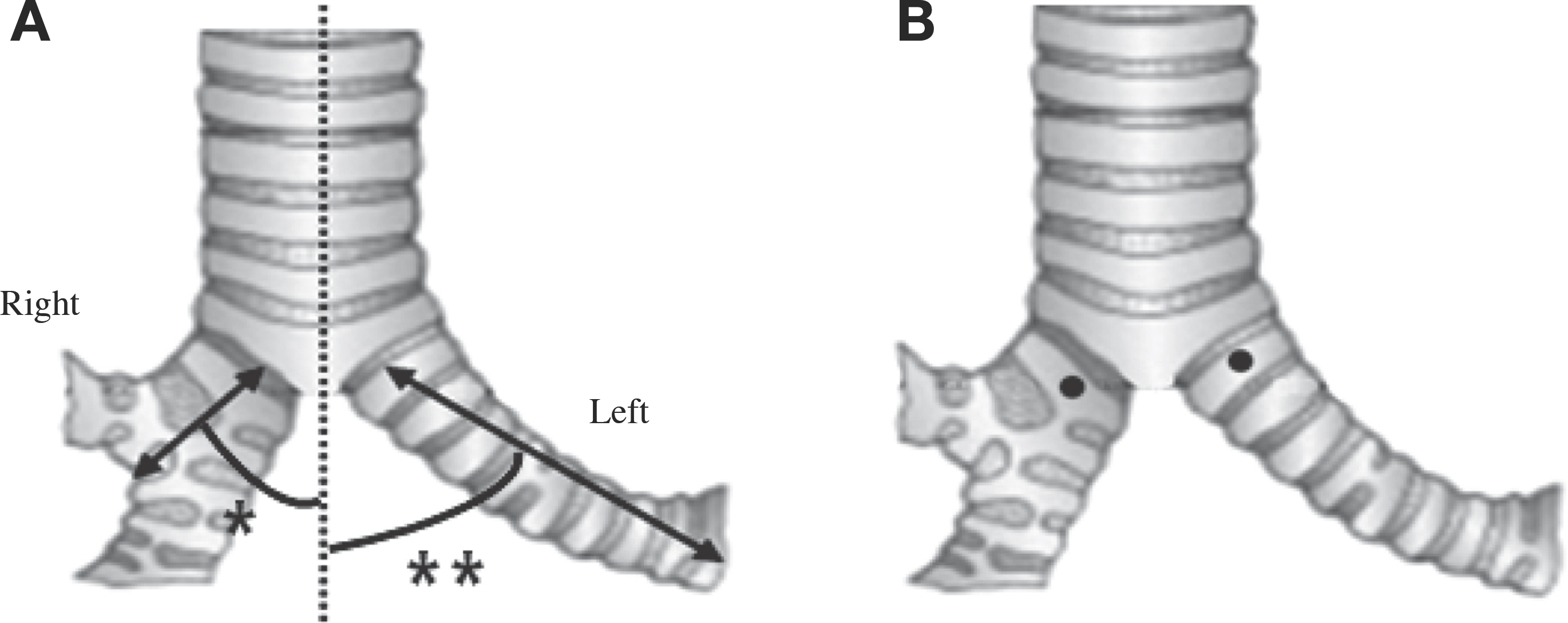Korean J Phys Anthropol.
2017 Mar;30(1):7-14. 10.11637/kjpa.2017.30.1.7.
The Morphometric Study of Main Bronchus in Korean Cadaver
- Affiliations
-
- 1Department of Anatomy, Chonbuk National University Medical School and Institute for Medical Sciences, Chonbuk National University, Korea. asch@jbnu.ac.kr
- KMID: 2374771
- DOI: http://doi.org/10.11637/kjpa.2017.30.1.7
Abstract
- This morphometric study of main bronchus was performed to provide the basic data necessary for anatomists, anesthetists and emergency medical technicians. A total of 48 cadavers, 33 men and 15 women, were used in this study. When it comes to their average age, men were 70 years old (50 to 91 years old), and women were 74 years old (47 to 92 years old). For this study, the length of the left and right main bronchi and the angle between them, and the first bronchial cartilage's each anteroposterior diameter, transverse diameter, vertical height, and distance between posterior ends of cartilage were measured. As for the length, left length was longer than right length regardless of gender, and there was no significant difference between men and women. When it comes to anterorposterior diameter, transverse diameter, and distance between posterior ends of the first bronchial cartilage in main bronchi, the right side was longer and wider than left side regardless of gender, but statistical significance was shown only in the distance between posterior ends of cartilage. Vertical height of the first bronchial cartilage in main bronchi did not show any difference between the left and right and between men and women, and men cadavers had a very large individual difference from 2.35 mm to 9.22 mm. As for the angle of the main bronchi's separation from trachea's major axis, the left side was larger than the right side in both men and women cadavers and it was larger in men than women, but there was no significant statistical difference. Lastly, as for the length of the main bronchi, the right and left lengths in men were 16.83±1.36 and 37.26±1.42 mm respectively; and the right and left lengths in women were 16.90±2.26 and 36.08±3.39 mm respectively. These results are expected to be used as the basic clinical data useful for medical procedures of emergency care practitioners, anesthetists and emergency medical technicians.
Keyword
MeSH Terms
Figure
Reference
-
References
1. Na MH, Kim JH, Hong MS, Na CY, Kim H, Shim JC, et al. A study on the measurement of the normal tracheal length in Korean adults. Korean J Thorac Cardiovasc Surg. 1995; 28:766–71. Korean.2. Shin CM, Shin YC, Cheong SH, Choi YK, Kim YJ, Park JW, et al. Study of lengths from the upper incisor to left and right mainstem bronchial carina in Korean adult using a fiberoptic bronchoscope. Korean J Anesthesiol. 2001; 40:572–6.3. Lee DH, Oh YH, Kim H, Woo SK, Suh SJ. Tracheal measurement by comupted tomography in Korean adult. J Korean Radiol Soc. 1988; 24:265–71. Korean.4. Park SH, Park SN, Kim MJ, Yoon HB, Chung DH, Chang HS, et al. Measurement of various dimensions of the larynx in Korean adult. J Soonchunhyang Med Sci. 1993; 9:29–30. Korean.5. Özmen S, Özmen OA, Ünal OF. Pediatric tracheotomies: a 37-year experience in 282 children. Int J Pediatr Otorhinolaryngol. 2009; 73:959–61.
Article6. Kang JY, Lee HS, Kim CH. Direct closure of post-intubation trachesophageal fistulas-report of 3 cases. Korean J Thorac Cardiovasc Surg. 1996; 29:1045–9. Korean.7. Jo YS. Study on complication rate of endotracheal intubation in the emergency. Graduate School Hanyang University 2012. Korean.8. Mort TC. Complications of emergency tracheal intubation: immediate airway-related consequences: part II. J Intensive Care Med. 2007; 22:208–15.
Article9. Lee KH, Lim HK, Lee KM, Kim SY, U HY. The incidence of sore throat and hoarseness after double-lumen endobronchial intubation. Korean J Anesthesiol. 1998; 35:484–7. Korean.10. Lee KH, Lim HK, Yoon KB, Um DJ, Lim HK. Movement of double-lumen endobronchial tubes during position change. Korean J Anesthesiol. 1994; 27:1164–8. Korean.11. Lee SC, Son JC, Lee BG. The depth of double lumen endobronchial tube and the effect of lateral decubitus position to the depth in Korean adult patients. Korean J Anesthesiol. 1997; 32:390–6. Korean.
Article12. Kim MS, Koh EJ, Choi HY. Occurrence of acquired tracheoesophageal fistula due to excess endotracheal tube cuff volumes. Korean J Crit Care Med. 2013; 28:146–51. Korean.13. Shin YD, Bae JH, Kim ST, Lim SW, Hong JS, Lee SJ, et al. Tracheobronchial rupture during double lumen endobronchial tube insertion for one-lung ventilation: 2 cases. Korean J Anesthesiol. 1999; 37:1149–52.14. Kwak YH, Kim YM, Yang HJ, Jung HS. Manual of emergency airway management. 2nd ed.Seoul. Koonja Publication;2005. p. 120–2. Korean.15. Suh GJ. Endotracheal intubation in emergency department. J Korean Soc Emerg Med. 1998; 9:560–70. Korean.16. Lee SK, You CW. An anthropometric measurements of the upper airway using fiberoptic laryngoscope in Korean adults. Korean J Crit Care Med. 1997; 12:143–50. Korean.17. Brodsky JB, Lemmens JM. Left double-lumen tubes: Clin-ical experience with 1,179 patients. J Cardiothorac Vasc Anesth. 2003; 17:289–98.18. Mi W, Zhang C, Wang H, Cao J, Li C, Yang L, et al. Mea-surement and analysis of the tracheobronchial tree in chinese population using computed tomography. PLoS One. 2015; 10:e0123177.
Article19. Kamel KS, Lau G, Stringer MD. In vivo and in vitro morphometry of the human trachea. Clin Anat. 2009; 22:571–9.
Article
- Full Text Links
- Actions
-
Cited
- CITED
-
- Close
- Share
- Similar articles
-
- Bronchoplastic Procedures after Sleeve Resextion of Left Main Bronchus Including Left Lower Lobe (A Case Report)
- A Case of Displaced Lobar Tracheal Bronchus Associated with Bronchiectasis
- Right Intermediate Bronchial Mass and Sudden Onset of Respiratory Symptoms
- A Case of Bronchial Stenosis due to Endotrcheal Suction
- Reconstruction of Tracheobronchial Stenosis due to Endobronchial Tuberculosis : A case report



